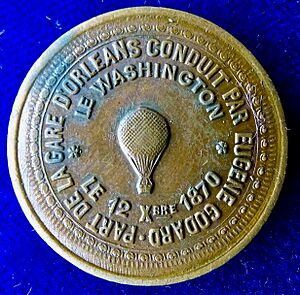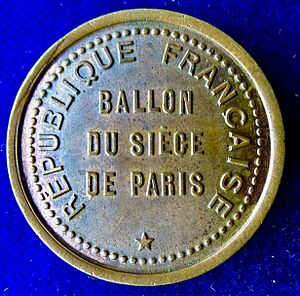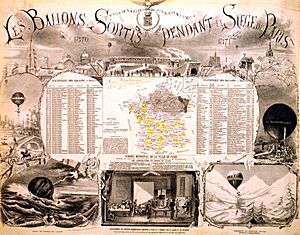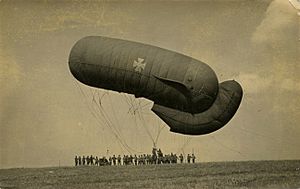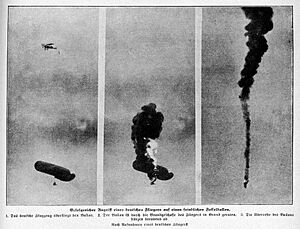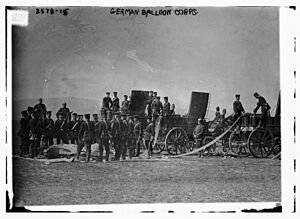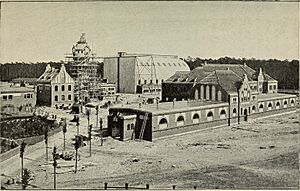History of military ballooning facts for kids
Balloons and kites were the first flying objects used in wars. Their main job was to scout and gather information. Balloons could lift an observer high above the battlefield. This gave them a "bird's-eye view" of enemy troops and their movements. They were great for making accurate maps of the battlefield. This was very important for winning battles.
Some balloons were even used to carry fire or small bombs. These were called incendiary balloons. They could destroy enemy areas. The idea of using balloons in war started in the late 1700s. The Montgolfier brothers in France first showed how hot-air balloons could be used by the military.
The French military first used balloons to spy on enemies during the French Revolutionary Wars. Balloons were also used during the American Civil War for scouting and sending messages. After World War I, balloons were used less often. This was because new aircraft like planes became more common. Today, drones and satellites do most of the jobs balloons used to do.
Contents
Kongming Lanterns: Ancient Sky Signals
Kongming lanterns were used as signals in ancient wars. These lanterns are like small hot-air balloons made of paper. They were invented in China during the Han dynasty. A smart leader named Zhuge Liang (also called Kongming) used them to signal for help when he was surrounded by enemies.
The Kongming lantern became a common way to send signals in China. The Mongolian army learned about them from China. They even used them in Europe during the Battle of Legnica. This was the first time people in the Western world knew about balloons. Today, flying Kongming lanterns is a fun tradition during the Lantern Festival. People remember Zhuge Liang during this time.
Early Western Military Balloons
French Balloons Take Flight
The first successful balloons in the West were made in France by the Montgolfier brothers in the 1780s. These balloons were like big, light eggs made of cotton or silk over a wooden frame. They were filled with hot smoke, which made them rise. The hot air in the smoke was what actually made them float.
The French military first used a balloon in battle in 1794. It was called l’Entreprenant and was used at the Battle of Fleurus (1794). The next year, a balloon was used again during the Siege of Mainz (1795). However, the French leader Napoleon later stopped the balloon corps in 1799.
In 1804, Napoleon thought about invading England using balloons. He asked a famous balloonist, Sophie Blanchard, if it was possible. She told him the winds over the English Channel were too tricky.
Later, in 1854, a French balloonist named Eugène Godard showed off balloons for the Austrian Emperor. The Emperor was so impressed that he wanted Godard to build balloons for his army. But in 1859, France went to war against Austria. Godard's balloons were then used by the French army instead. They helped France win battles. Godard's balloons were used again by the French in 1870 during the Franco-Prussian War. They were very important during the Siege of Paris (1870–71).
Austria's Bombing Balloons in 1849
The first time balloons were used to attack an enemy was in 1849. Austrian forces were trying to capture the city of Venice. They tried to float about 200 paper hot-air balloons over the city. Each balloon carried a bomb that would drop with a time fuse.
The Austrians launched most balloons from land. Some were even launched from a ship called the SMS Vulcano. They used smaller balloons first to figure out the right time for the bombs to drop. At least one bomb landed in the city. But the wind changed, and most balloons missed their target. Some even drifted back over the Austrian lines and the ship!
Balloons in the American Civil War
When the American Civil War began, President Abraham Lincoln thought about using balloons. Many top balloonists wanted to lead a new air division. Professor Thaddeus S. C. Lowe was chosen to be the Chief Aeronaut of the Union Army Balloon Corps.
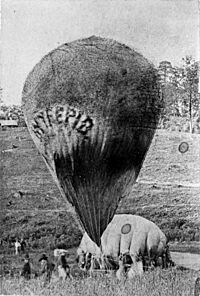
The Union Army Balloon Corps was the first large-scale use of balloons in the military. At first, balloons were filled with city gas and walked to the battlefield. This was hard work. Later, they used special machines to make hydrogen gas on the spot. This made it easier to inflate balloons in the field. Lowe built seven balloons for military use.
One of the first jobs for balloons was to help make maps from the sky. General Irvin McDowell quickly saw how useful they were for spying on enemy troops. Lowe's balloons were used at the First Battle of Bull Run. Lowe also helped direct artillery fire. He used flag signals from his balloon to tell gunners where to shoot. This was a first in military history!
Lowe's first military balloon, the Eagle, was ready in October 1861. It was towed from Washington, D.C., to the battlefield. This was a long, 12-hour trip. A strong wind ripped the balloon away, and it floated out to sea. After this, balloon activities stopped until all balloons and gas generators were ready.
Lowe later put his new balloon, the Washington, and two gas generators on a converted coal barge. This ship was called the George Washington Parke Custis. As the ship moved down the Potomac River, Lowe could go up in his balloon and watch the battle. This was the first time an aircraft carrier (or balloon carrier) was used!
The Union Army Balloon Corps did well in battles like the Peninsula Campaign. But the military's opinion of balloons got worse. By August 1863, the Balloon Corps was shut down.
The Confederate Army also used balloons. But they had trouble getting supplies because of blockades. They had to make their balloons from colored silk dress material. Their use was limited because gas was hard to find. The first Confederate balloon pilot was Edward Porter Alexander. By mid-1863, all balloon spying in the Civil War had stopped.
First Balloon Missions
The first job for military balloons was to help the Union Army's engineers make maps. Before this, maps were made from the ground and were often wrong. Maps made from the sky were much better, especially with photography.
General Irvin McDowell asked for balloons to watch enemy camps at the First Battle of Bull Run. Lowe showed how useful his methods were. He was then asked to build seven balloons and gas generators for the battlefield.
Lowe's balloon, the Eagle, was also used to direct artillery fire. It was tethered (tied down) and had a telegraph line. Lowe used flag signals to tell the artillery where to shoot. This idea of a forward artillery observer changed how artillery was used forever.
In 1863, a young German observer named Ferdinand von Zeppelin wanted to fly with Lowe. But the Union Army did not allow it because he was a civilian. Von Zeppelin later became famous for creating airships.
The First Aircraft Carrier
Balloons and their gas generators were loaded onto the USS George Washington Parke Custis. This was a coal barge that was changed to carry balloons. The balloons were towed down the Potomac River. From the balloons, observers could watch the battle as it moved towards Richmond. On November 11, 1861, Lowe made the first observations from a balloon launched from a ship. This was like the first-ever aircraft carrier for balloons.
Lowe continued to make observations at battles like Fair Oaks and Sharpsburg. But due to problems within the military and in Congress, he had to resign in April 1863. The Balloon Corps then mostly stopped existing by August 1863.
Confederate Ballooning Efforts
The Confederates also tried to use balloons to counter the Union's efforts. One type was a hot-smoke balloon made of cotton. These worked, but they were hard to control and often lost or captured by the North.
Another type was called the "silk dress balloon." These were made from colorful silk fabric. When gas was available, they were used effectively over Richmond. But again, they were often lost or captured. The lack of supplies made it impossible to replace them. The Confederates were relieved when the Union Army stopped using balloons.
The Confederate Balloon Corps also used a ship as a balloon carrier, the CSS Teaser. It carried and launched a Confederate balloon for observations. But the Union Navy captured the Teaser in July 1862.
Balloons in the Paraguayan War
In 1867, during the Paraguayan War, Brazil used observation balloons. They were helped by the Allen brothers, James and Ezra. These brothers had helped the Union army with their aerial spying.
British Military Balloons
From 1862 to 1871, two British officers tried to show the British Army how useful balloons could be. In 1863, they did successful experiments for scouting. But the army thought it was too expensive. However, by 1878, a Balloon Equipment Store was set up in Woolwich. By this time, they had found ways to make hydrogen gas in the field. They also found good materials for the balloons.
In 1888, a School of Ballooning was started in Chatham, Medway. It moved to Aldershot in 1890. A permanent balloon section was then formed in the Royal Engineers.
The British Army first used balloons in Africa in 1885. They also used them during the Second Boer War (1899–1902). They helped spot targets for artillery during the Siege of Ladysmith.
In 1907, Colonel John Capper and his team flew a military airship called Nulli Secundus over London. This was done to get public interest in military airships.
World War I: The Golden Age of Observation Balloons
World War I was the most important time for military observation balloons. Both sides used them a lot. At first, the British used round balloons. But these were quickly replaced by "kite balloons." These could fly better in bad weather. The Germans used the Parseval-Siegsfeld type, and the French used the Caquot type.
By World War I, artillery guns could shoot much farther than soldiers on the ground could see. Putting artillery observers in balloons, a few miles behind the front lines, allowed them to see targets far away. This helped the artillery use its full range.
Because balloons were so important for spotting, they were heavily protected. They had anti-aircraft guns, machine guns, and patrolling fighter aircraft. Attacking a balloon was dangerous, but some pilots loved the challenge. These pilots were called "balloon busters." Famous ones included Belgium's Willy Coppens and America's Frank Luke. Many expert balloon busters stayed above 1,000 feet to avoid enemy fire.
Observation balloon crews in World War I were the first to use parachutes. These were simple parachutes where the main part stayed in a bag attached to the balloon. The pilot wore a harness. When they jumped, the parachute would pull out of the bag. The Germans first used this type of parachute. Later, the British and French also adopted them for their balloon crews.
Towards the end of World War I, observation balloons were also used at sea to look for enemy submarines.
The saying "The balloon's going up!" means that a battle is about to start. This comes from the fact that a balloon going up often meant an attack was coming.
World War II: New Uses for Balloons
Barrage balloons, often called "blimps," were used by the United Kingdom in World War II. They were meant to stop German bombers and V-1 cruise missiles. These balloons floated in the sky with cables. Enemy planes could hit the cables, causing them to crash.
Japan used newly found high-altitude air currents to send fire balloons across the Pacific Ocean. These balloons carried bombs to the United States. About 300 of them reached the US, causing some damage and a few deaths. The US government kept these incidents secret. They worried what would happen if Japan started using these balloons to deliver biological weapons.
Britain also used free-flying balloons in different ways. In Operation Outward, they launched almost 100,000 small balloons. These balloons dropped fire-starting devices on German-occupied Europe. They also trailed wires to short out electrical power lines.
Balloons were also used at sea, especially by the US Navy for finding submarines.
The Red Army of the Soviet Union used observation balloons to spot targets for their artillery. They had 8 "Aeronautical Sections." During the war, Soviet balloonists made nearly 20,000 observation flights, totaling over 20,000 hours in the air. About 110 Soviet observation balloons were lost.
Balloons After the Wars
After World War II, the US military developed high-altitude balloons. These were used to detect nuclear explosions and for spying. Programs like Project Mogul (linked to the Roswell Incident) and Project Genetrix were examples. They also worked on the E77 balloon bomb, improving on the Japanese fire balloon idea.
Project Genetrix was a program in the 1950s run by the US Air Force, Navy, and CIA. They launched hundreds of spy balloons over China, Eastern Europe, and the Soviet Union. These balloons took photos and collected information. They were disguised as weather research balloons. The balloons were very tall, carried cameras, and flew very high. Many were shot down by Soviet air defenses. Other countries protested these flights. The US later replaced these balloons with the U-2 spy plane, which was harder to detect.
Also in the 1950s, the Fulton surface-to-air recovery system was created. This system used a balloon to lift people from the ground so an aircraft could pick them up.
Since 1996, the United States has spent a lot of money on the JLENS project. This project built aerostats (tethered balloons) to track low-flying targets like cruise missiles. The project got attention when some balloons accidentally broke free.
Aerostats have been used by US and allied forces in Iraq and Afghanistan.
In 2019, the US military tested 25 spy balloons over six states. These balloons were stealthy and used AI to navigate. They could collect complex data. Experts say these balloons can help with communication, track targets, and carry different weapons.
Around the same time, DARPA and defense companies worked on the ALTA program. This aimed to make stratospheric balloon navigation more accurate. This technology was given to the US military in 2019.
Other similar balloons are being developed in China and the United States.
In 2023, suspected spy balloons from China reportedly drifted over North and Central America.
During its 2022 invasion of Ukraine, Russia launched balloons with special reflectors. These were meant to make Ukraine's air defenses waste their missiles.
See also
- Aerial warfare
- Balloon (aeronautics)
- Balloon propaganda campaigns in Korea
- Barrage balloon
- Fort Omaha Balloon School – where World War I balloon training happened
- Incendiary balloon – history of balloon bombs from Japan in World War II
- Observation balloon
- Operation Outward – British World War II program using free-flying balloons to attack Germany
- Roswell incident - A military balloon crash that led to conspiracy theories about flying saucers
- Thaddeus S. C. Lowe – considered the father of military aerial spying in the United States
- Union Army Balloon Corps
- 2023 Chinese balloon incident



